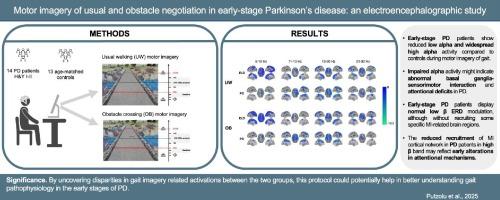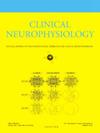Motor imagery of usual walking and obstacle negotiation in early-stage Parkinson’s disease: An electroencephalographic study
IF 3.6
3区 医学
Q1 CLINICAL NEUROLOGY
引用次数: 0
Abstract
Objective
To assess gait imagery related activations by means of high-density electroencephalography (hdEEG) in a population of early-stage PD patients and age-matched healthy controls.
Methods
Fifteen patients with early-stage PD (Hohen & Yahr range: 1–2.0) and 14 age matched controls were recruited. They were asked to visually imagine walking on a straight pathway and on a straight pathway while crossing a hurdle in the middle. We registered hdEEG in the participants and analyzed α and β bands Event Related Desynchronizations (ERDs).
Results
PD patients showed reduced low α and high β activity and more widespread ERDs in the high α range compared to the controls. On the contrary, a similar behavior in the low β band was found between the two groups.
Conclusions
Findings about α activity in PD might indicate an abnormal basal ganglia-sensorimotor interaction (high α), together with attentional and executive functions deficit (low α). Low β ERD modulation is normal in patients with PD, whereas high β ERD results may indicate top-down control impairments.
Significance
By uncovering disparities in gait imagery related activations between the two groups, our protocol could potentially help in better understanding gait pathophysiology in the early stages of PD.

早期帕金森氏症患者正常行走和过障的运动意象:脑电图研究。
目的:通过高密度脑电图(hdEEG)评估早期PD患者和年龄匹配的健康对照人群的步态图像相关激活。方法:招募15例早期PD患者(Hohen & Yahr范围:1 ~ 2.0)和14例年龄匹配的对照组。他们被要求在视觉上想象在一条笔直的小路上行走,在一条笔直的小路上行走,同时穿过中间的一个障碍。我们记录了参与者的hdEEG,并分析了α和β带事件相关不同步(ERDs)。结果:与对照组相比,PD患者低α和高β活性降低,高α范围的erd更广泛。相反,在低β波段,两组之间存在相似的行为。结论:PD中α活性的变化可能提示基底神经节-感觉运动相互作用异常(高α),同时伴有注意和执行功能缺陷(低α)。低β ERD调节在PD患者中是正常的,而高β ERD结果可能表明自上而下的控制障碍。意义:通过揭示两组之间步态图像相关激活的差异,我们的方案可能有助于更好地理解PD早期阶段的步态病理生理。
本文章由计算机程序翻译,如有差异,请以英文原文为准。
求助全文
约1分钟内获得全文
求助全文
来源期刊

Clinical Neurophysiology
医学-临床神经学
CiteScore
8.70
自引率
6.40%
发文量
932
审稿时长
59 days
期刊介绍:
As of January 1999, The journal Electroencephalography and Clinical Neurophysiology, and its two sections Electromyography and Motor Control and Evoked Potentials have amalgamated to become this journal - Clinical Neurophysiology.
Clinical Neurophysiology is the official journal of the International Federation of Clinical Neurophysiology, the Brazilian Society of Clinical Neurophysiology, the Czech Society of Clinical Neurophysiology, the Italian Clinical Neurophysiology Society and the International Society of Intraoperative Neurophysiology.The journal is dedicated to fostering research and disseminating information on all aspects of both normal and abnormal functioning of the nervous system. The key aim of the publication is to disseminate scholarly reports on the pathophysiology underlying diseases of the central and peripheral nervous system of human patients. Clinical trials that use neurophysiological measures to document change are encouraged, as are manuscripts reporting data on integrated neuroimaging of central nervous function including, but not limited to, functional MRI, MEG, EEG, PET and other neuroimaging modalities.
 求助内容:
求助内容: 应助结果提醒方式:
应助结果提醒方式:


